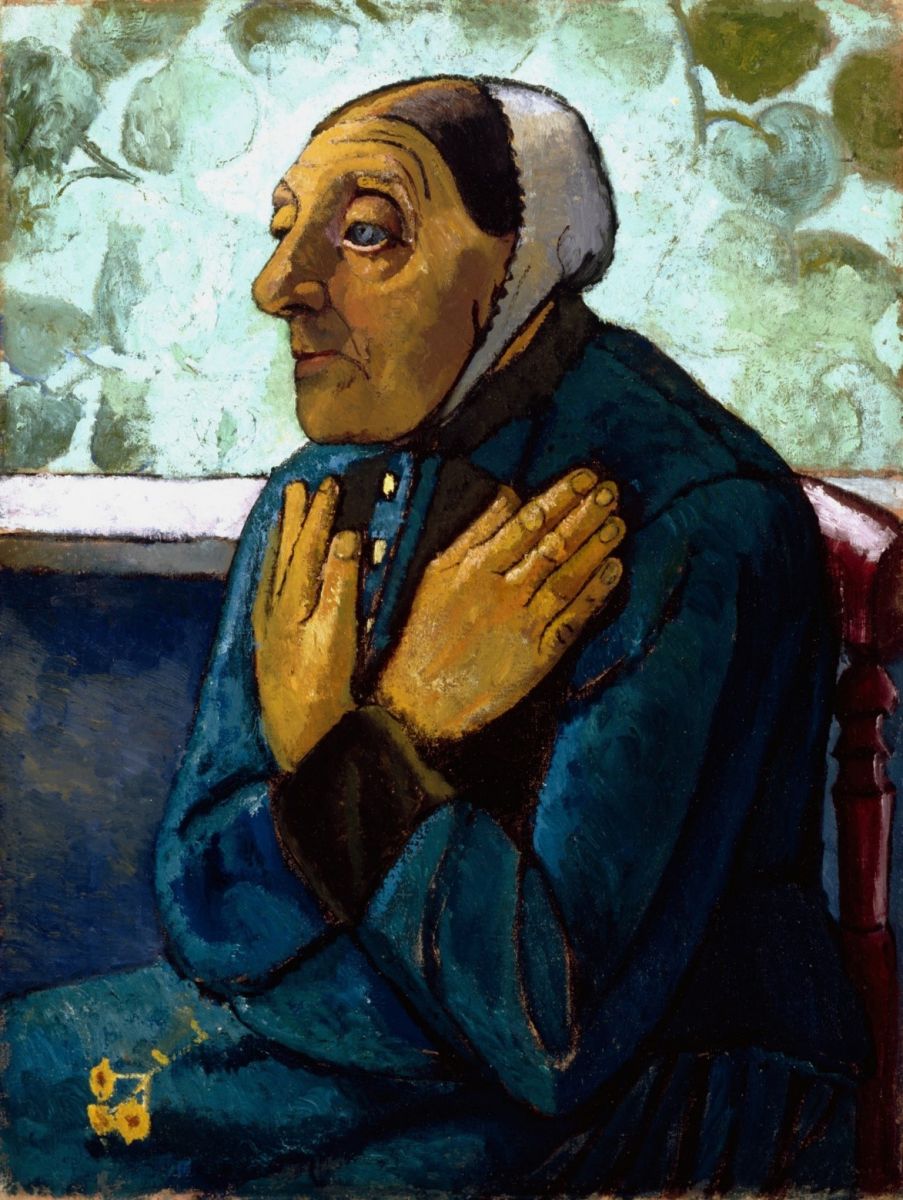Advent 4 - Annunciation, Paula Modersohn-Becker
Paula Modersohn-Becker: Old Peasant Woman

Biblical Simplicity
by Deborah Lewer
An old woman, dressed in blue, is seated in an indeterminate space. Her gaze is unfocused, her posture one of reflective stillness. Her large, strong hands are crossed at her breast, in an attitude of prayer. A small golden flower lies in her lap. There is a subtle light around her head, like a nimbus.
Paula Modersohn-Becker (1876-1907) painted this work in about 1905 in the small, remote, north German village of Worpswede. She had joined a community of artists there, all drawn to the broad landscape of marshes and birch woods and to the idea of simplicity. Her subject is a woman of the local poorhouse. She painted and drew her many times, paying her a small amount to sit for hours, while the artist observed the bent body, weather-worn face, rough hands, and basic clothes, striving for what she called “the utmost simplicity united with the most intimate power of observation”.
The painting tells us something of what it was to be an elderly German woman, with a life of work on the land and at home behind her, living in rural poverty. It tells us other things about an era of modernity that left rural communities behind, or emptied them, or made them into curiosities for urbanites seeking remnants of a lost past. But this painting is also a vivid and deeply humane revisioning of one of the most poignant and pivotal images of art and of Christian tradition: the Annunciation.
The museums and churches of Europe are full of them: an illogically pale young virgin, most commonly on the right, facing left, almost always in blue, receiving the angelic messenger. Asking “how can this be?” Following Renaissance traditions the virgin’s bodily gestures dramatise stages of her response – disquiet, reflection, inquiry, acquiesence. The posture of prayer that this old peasant adopts in a distant German village most closely echoes the virgin annunciate’s gesturing of humility and acceptance. She is seated in an unspecified environment. There are no books, lilies, beds or vases. But the foliage beyond her bulky body suggests a garden at the same time that it resembles a patterned wallpaper. There’s an echo, very distant, of the enclosed garden, the hortus conclusus, in which tradition has long placed the virgin. The painting draws together youth and age, tradition and modernity, the extraordinary and the ordinary, imagination and observation, the sacred and the secular.
Modersohn-Becker spent her most formative years studying and immersing herself in art in Paris. As well as learning from Gauguin, from Cézanne and others, she would go daily to the Louvre. She knew these gestures, these eloquent conventions, and how great artists broke them, too. And when she returned yet again, to the peat bogs of Worpswede, she met the “biblical simplicity”, as she described it, of the peasants there, and painted them, bold, modern and new.
We are entering the season of Lent. Forty days. A time for leaving familiar comforts and company to go into the wilderness, to fast, and to pray. In 2021 many of us are longing for an end to isolation and renunciation. I wonder about this painting as one for our Lent: with its image of habituated, intimate, ordinary prayer we might see in it both the call to relinquish what we do not need and accept what we have and the promise of new life, of hope, that the Annunciation heralds.
This painting was made by one woman not known to pray observing another from a community for whom prayer was woven into the fabric of life. What do we see, through their eyes?
*******
Paula Modersohn-Becker: Old Peasant Woman, oil on canvas, c. 1905, Detroit Institute of Arts.
Paula Modersohn-Becker (1876-1907) gained no public recognition as an artist during her short lifetime and died from complications after childbirth in 1907. The artist’s works were finally being recognised in Germany for their astonishing originality by 1919. This painting was acquired for the collection of the Hamburg Kunsthalle in that year. But in 1937 it was confiscated, along with many other works by the artist as part of the National Socialists’ attempt to eradicate the so-called ‘degenerate art’ of German public collections. It was sold on the international market for 120 US dollars. In 1958 the US collector who bought it from a gallery donated it to the Detroit Institute of Arts.
Dr. Deborah Lewer is Senior Lecturer in History of Art at the University of Glasgow, Scotland. She is a specialist in 20th century German art and in the relationship between art and theology as well as politics. She is an expert on the most radical movement in the history of modern art, Dada. She is also a regular speaker in churches, theological colleges and at festivals, a popular retreat leader, a writer and occasional broadcaster.
ArtWay Visual Meditation 21 February 2021






